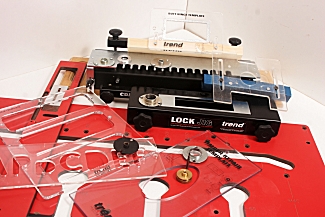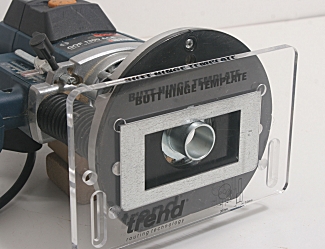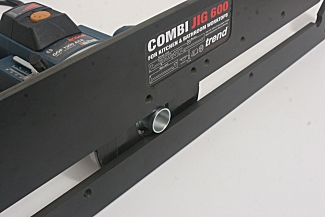GUIDE BUSHES PART TWO: COMMERCIAL JIGS & TEMPLATES – AN INTRODUCTION

Many of the most useful and popular commercial router jigs work with guide bushes. Examples include dovetail, hinge, mortise and tenon, kitchen worktop, and door lock jigs; lettering and numbering templates, letterbox templates, and inlay templates. All of these devices either come with a guide bush or specify the diameter of bush to use. The main consideration then is whether the guide bush that comes with the particular jig or template fits your router, or whether the range available for your own model includes one of the required size. If the answer to both these questions is ‘NO’ the next question is whether the jig’s bush can be made to fit by using an adaptor plate such as the Trend Unibase or Circular Sub-Base.
(See in our online shop the Trend Unibase and the Trend Circular Sub-Base.)
Most commercial jigs and templates, whoever they are made by, use the long-established Elu/De Walt/ Trend standard guide bushes. A few, such as Bosch and Festool jigs, use their own quick-fitting bushes, while one or two others, such as the Leigh and De Walt dovetail jigs, use the American-style two-part bushes for which Trend offer a special circular sub-base. The Leigh jigs also offer screw-on bushes which, while not looking like the standard Elu/De Walt/ Trend bushes, nevertheless fit directly to all those routers that take this most popular type.
It all goes to emphasis the importance, when choosing your router, of having a good idea of what it is capable of, and what you are likely to want to do with it. If you plan to do much guide-bush work, you need a model that takes the widest possible range of bushes. All the jigs and templates shown in this article are part of my workshop equipment and I can vouch for their efficiency.

Guide bush length
The most important measurement on a guide bush is the outside diameter, and this is the dimension quoted in manufacturers’ catalogues. Also of importance, however, is the length of the spigot i.e. the amount by which the bush projects from the router base when installed in the router. If this projection is longer than the thickness of the jig or template the bush will not have clearance over the workpiece.
With the standard Elu/De Walt/Trend bushes the spigot is 6mm long, projecting about 4mm from the router base, which means that jigs and templates can be made of materials as thin as 6mm. Moreover, the spigot length is the same irrespective of the diameter of the bush, thus a template made of 6mm Perspex can be used with any standard Trend bush. This is not always the case, however.
For instance, with the quick release Bosch bushes the spigot length increases with the diameter. This not only stops you switching bushes with a thin template but also deters you from using the larger bushes with some commercial devices.

As an example, the first jig described below – a single butt hinge jig – requires a 30mm diameter guide bush in the router. Bosch include a 30mm bush in their range but when fitted to the router, it projects 13.75mm whereas the thickness of the plastic template is only 8mm.

A similar situation arises with some kitchen worktop jigs.

One solution to this problem is to reduce all your Bosch bushes to the length of the smallest diameter one. If, like me, you have no metalworking facilities, you can find a jobbing engineering shop from your Yellow Pages or the internet and have them do it for you. An alternative is to make a false base for your router thick enough to give clearance to the longer bushes. In other words, if you can’t lower the bush raise the router. I use a false base made from 9.5mm MDF laminated both sides. It replaces the existing black plastic sole plate when required.
Conversely, there are one or two jigs where an extra long bush is specified. For example a standard 30mm Trend bush, 6mm long, can be used with kitchen worktop jigs but Trend also offer one with a 10mm spigot for added stability. Other examples include the Trend letterbox jig and Contractor Hinge Jig. With the latter, a 16mm guide bush with a spigot 10mm deep is specified.

Guide bush collars
Some jobs, such as inlaying, require two guide bushes of different diameter. Other jobs, such as door hanging and hingeing move straight on from one job to the next and also require two different diameter bushes. One way of achieving this without having to change one bush for another is to use the smaller diameter bush and then bring it up to the larger diameter by fitting a collar to it. The collar is a push fit and increases the effective diameter of the bush.
Collars consist of an alloy ring, grooved on the inside to take a rubber ‘O’ ring, which grips the spigot of the guide bush and prevents it working loose while routing.
Another example is shown in Pic 14 with the Trend mortise and tenon jig.
(See in our online shop Guide Bushes and Bases in the Accessories section.)
The following items are available to buy online:

